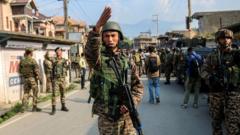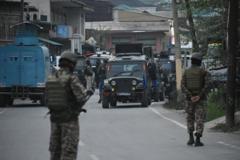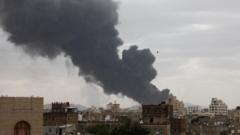In a significant escalation of conflict, India has carried out air strikes targeting militant sites in Pakistan, leading to claims of casualties and the shootdown of Indian jets. Analysts debate the potential for Pakistani retaliation and the risk of a larger conflict.
Rising Tensions: The Aftermath of India's Air Strikes on Pakistan

Rising Tensions: The Aftermath of India's Air Strikes on Pakistan
India's recent air strikes over Pakistan have escalated tensions, prompting potential retaliatory actions from Islamabad. The international community watches closely.
In a dramatic overnight operation, India launched missile and air strikes against nine sites across Pakistan and Pakistan-administered Kashmir, targeting what it classified as militant positions based on "credible intelligence." The strikes, lasting just 25 minutes between 01:05 and 01:30 India time, created an uproar in the region, waking residents with booming explosions. Pakistan reported that six locations were hit during the air strikes and claimed to have shot down five Indian fighter jets and a drone, an assertion India has not confirmed. Casualty reports indicate that at least 26 people died and 46 were injured in the strikes and subsequent shelling across the Line of Control (LoC), while India reported the deaths of 10 civilians due to Pakistani fire on its side of the border.
This significant escalation follows last month's deadly militant attack on tourists in Pahalgam in Indian-administered Kashmir, igniting heightened tensions between the nuclear-armed neighbors. India has stated it possesses clear evidence linking terrorist activities to elements operating from Pakistan, a claim fiercely denied by Islamabad, which contends that India has failed to provide proof for its allegations.
Experts are questioning whether this latest operation signals a new level of escalation. Historically, incidents such as the 2016 Uri attack and the 2019 Pulwama bombing have resulted in similar military actions. However, experts highlight that this response appears broader in scope, simultaneously targeting infrastructure associated with multiple militant groups, including Lashkar-e-Taiba and Jaish-e-Mohammed.
Srinath Raghavan, a Delhi-based historian, emphasized that the current strikes reflect a shift from previous retaliatory measures, targeting not just Kashmir, but venturing deeper into Pakistan's Punjab province. Ajay Bisaria, a former Indian diplomat, described the strikes as a “Balakot plus response,” aimed at re-establishing deterrence without escalating into full-scale conflict.
The potential for retaliation from Pakistan seems inevitable, with experts predicting that Islamabad will feel compelled to respond militarily to avoid signaling weakness. Some anticipate surgical strikes targeting Indian military locations. The dilemma now rests on how both nations manage the inevitable escalation.
In Pakistan, analysts observe that public sentiment regarding military and political actions has shifted since earlier conflicts, suggesting a nuanced response. With tensions boiling, both countries are currently navigating a precarious situation, balancing diplomatic relations while preparing for potential military actions.
Comparative analyses to past conflicts indicate a high risk of escalation, which could lead to a broader confrontation, signaling the most dangerous phase in India-Pakistan relations since 2002. Despite the challenges, some experts hope this crisis can be resolved with limited reciprocal strikes and efforts at de-escalation, stressing the critical importance of diplomatic channels in decreasing tensions post-strike. As events unfold, the international community remains watchful, aware that the potential fallout could hold profound implications for regional stability.





















